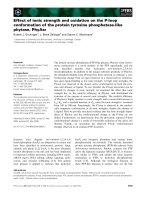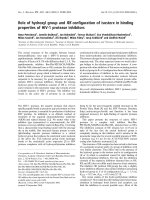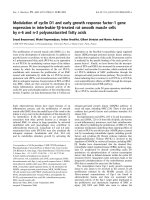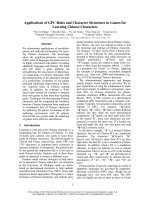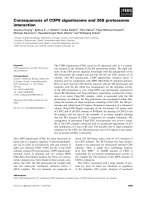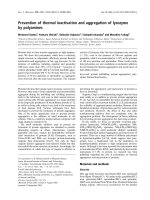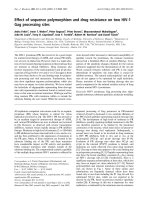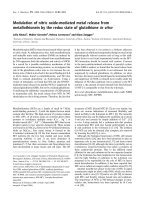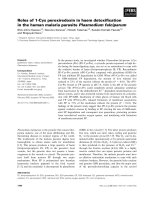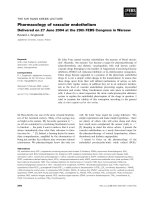Báo cáo " Reconstructing sedimentary environments of MR1 core and investigating facies’ geotechnical properties through the piezocone penetration test in the Late Pleistocene-Holocene periods in the Mekong River Delta " docx
Bạn đang xem bản rút gọn của tài liệu. Xem và tải ngay bản đầy đủ của tài liệu tại đây (287.78 KB, 13 trang )
VNU Journal of Science, Earth Sciences 26 (2010) 19-31
19
Reconstructing sedimentary environments of MR1 core and
investigating facies’ geotechnical properties through the
piezocone penetration test in the Late Pleistocene-Holocene
periods in the Mekong River Delta
Truong Minh Hoang
1,
*, Nguyen Van Lap
2
, Ta Thi Kim Oanh
2
, Takemura Jiro
3
1
Ho Chi Minh University of Science, VNU
2
Vietnamese Academy of Science and Technology, HCMC Institute of Resources Geography
3
Tokyo Institute of Technology, Japan
Received 14 September 2010; received in revised form 24 September 2010
Abstract. The aim of the study was to reconstruct sedimentary environments of the MR1 core and
investigate geotechnical properties of sedimentary facies through the piezocone penetration test
(CPTU). A core at the Vinhlong province, Mekong River Delta (MRD), sufficiently presented the
Holocene facies of the area. Eight facies were identified based upon sedimentary properties.
Characteristics of the units showed development of sedimentary facies. Each sedimentary facies
was formed under different environment.
Each sedimentary facies presents CPTU results differently. A facies has various sedimentary
structures and materials such as the estuarine channel, estuarine marine, and delta front mouth bar
facies; values of cone resistance, q
t
, sleeve friction, f
s
, and pore water pressure, u
2
, in its CPTU
results will increase highly, vary largely, and present in saw-tooth shape in the overall plot of them
as a function of depth. A facies’ sedimentary property is highly homogeneous such as the marsh,
bay, and prodelta facies; its values of q
t
, f
s
, and u
2
increase almost linearly with depth.
Keywords: Vinhlong; Late Pleistocene-Holocene; MRD; facies’ geotechnical properties; CPTU.
1. Introduction
∗
The late Pleistocene-Holocene sediments in
the MRD that has accumulated consist of
several sedimentary facies, each of which was
formed in a different sedimentary environment
and has typical sedimentary structures and
materials, and undergone complex changes
[1,2]. The geotechnical properties in the MRD
curious trends [3]. The sediments, sedimentary
_______
∗
Corresponding author. Tel.: 84-8-38258156.
E-mail:
structures, and the post-depositional processes
affect the geotechnical properties [4,5].
Therefore, studying sedimentary environment
change was conducted and the first step using
the CPTU test investigated the geotechnical
properties of the sedimentary facies.
2. Materials and Methods
The investigation was conducted in
Vinhlong province, MRD (Fig. 1). The
borehole (designated MR1) was located at
T.M. Hoang et al. / VNU Journal of Science, Earth Sciences 26 (2010) 19-31
20
latitude 10
o
14’ 2” N, longitude 105
o
59’ 8” E at
an altitude of +2 m and reached to a depth of -
46.05 m. Carbon isotope (
14
C) dating, grain
size, sedimentary structures were analyzed.
CPTU test was used as a field test, designated
CPTU1, was conducted to a depth of -47.8 m.
Soil-behavior-type classification of the
Vinhlong site was performed using the CPTU
results [6,7]. A distance of the MR1 borehole
and position of the CPTU1 test is 2m.
Fig. 1. Location of the MR1 (1), VL1 (2), and BT2 (3) boreholes [1, 2, and 8].
3. Results
3.1. Lithostratigraphy
Based on the sedimentary properties, the
sediments of the MR1 core can be divided into
eight lithostratigraphic units, the depositional
facies can then be inferred (Fig. 2), presented
below in ascending order.
1) Unit 1 (-46.05 to -41.5 m below present
sea level)
This unit consists of darkish and greenish-
gray silty clay to clayey silt and discontinuous
T.M. Hoang et al. / VNU Journal of Science, Earth Sciences 26 (2010) 19-31
21
fine sand laminae of 2 mm thick; it contains
scattered laterite (5-10 mm in diameter) and
angular quartz (maximum 15 mm in length)
pebbles (Fig. 3A). Parallel and lenticular
beddings are common. The plant fragments and
plentiful organic materials were found at a
depth of -44 to -41.35 m.
2) Unit 2 (-41.5 to -27.8 m)
This unit consists of two parts. The lower
part is characterized by inter-bedded, brownish-
gray silty clay and clayey to sandy silt. Faint
bedding exists in the brownish-gray silt (Fig.
3B). The upper part of unit 2 contains
discontinuous parallel laminae, wavy, flaser,
parallel and lenticular bedding, humus,
bioturbation, calcareous concretions, and
mollusca. Mica flakes are scattered throughout
the unit.
3) Unit 3 (-27.8 to -25 m)
This unit is divided into two parts. The
lower part, from -27.8 to -26.4 m, consists of
intercalated darkish gray silty sand to medium
sand and clayey silt to silty clay, coarsening
upward succession. The upper part, from -26.4
to -25 m, consists of greenish-gray silty sand
and greenish-gray clayey silt. In general, the
unit is characterized by parallel laminae, wavy
bedding, lenticular bedding (Fig. 3C), and flaser
bedding characterize the unit. The shell
fragments and humus are scattered throughout
the unit.
4) Unit 4 (-25 to -22.0 m)
This unit consists of darkish-gray clayey silt
in the lower part and greenish-gray clayey silt
and silty clay mud with discontinuous, very
thin sandy bedding in the upper part (Fig. 3D).
The grain distribution shows a fining-upward
succession. Humus matter, mica flakes, shell
fragments, and calcareous incipient are
scattered throughout the unit. The facies is high
homogeneity.
5) Unit 5 (-22.0 to -18.5 m)
This unit is divided into two parts. The
lower part, from -22 m to -20 m, includes gray
silty clay and very fine sand coarsening upward.
The sediments commonly present interbedded
greenish-gray clayey silt and silty clay and
discontinuous parallel laminated mud. The
upper part of the unit contains parallel
laminated sandy mud (Fig. 3E). In general,
mica flakes, calcareous nodules and calcareous
incipient are scattered throughout the unit (Fig.
3E).
6) Unit 6 (-18.5 to -5.5 m)
The unit contains an intercalated greenish-
gray clay and silt, greenish-gray sandy silt and
fine to coarse sand in a coarsening-upward
succession. It is inhomogeneous, with several
sandy layers of various thicknesses, some of the
sandy layers are relatively thick (Fig. 3F). In
general, medium to coarse sands are common
soil types of the unit (Fig. 2). Parallel laminae,
lenticular, flaser and wavy bedding, and fine to
coarse sand with parallel clayey laminae are
also common. Burrow, bioturbation, plant
fragments and mica flakes are scattered
throughout the unit.
7) Unit 7 (-5.5 to -1.5 m)
The unit consists of laminated greenish- and
darkish-gray clayey silt, sandy silt and very fine
to medium sand and shows parallel laminae,
discontinuous parallel laminae, lenticular and
wavy bedding. The deposits from –2.4 to –3 m
consist of intercalated sand and mud. Humus
matter, bioturbation and burrow (Fig. 3G) are
also present in this unit.
8) Unit 8 (-1.5 to +1 m)
The unit contains greenish-darkish gray
mud with small yellowish-greenish spots from -
1.5 to +0.5 m. The greenish- and darkish-gray
medium to fine sandy mud are from +0.5 to
+1.0 m and rich in organic materials.
T.M. Hoang et al. / VNU Journal of Science, Earth Sciences 26 (2010) 19-31
22
Fig. 2. Geological column of the MR1 core and its correlation with lithostratigraphic units.
T.M. Hoang et al. / VNU Journal of Science, Earth Sciences 26 (2010) 19-31
23
Fig. 3. Selected photographs of sedimentary structures of the MR1 core. A) (at depth -44.5 m) angular quartz
pebbles; clay mass. B) (-34.9 m) Faint bedding exists in the brownish-gray silt. C) (-25.08 m) lenticular bedding.
D) (-22.08 m) discontinuous, very thin sandy bedding. E) (-19.54 m) parallel laminated sandy mud, calcareous
nodules. F) (-10 m) sandy layers with various thicknesses. G) (-2.4 m) burrow.
3.2. Inferred depositional facies
In a similar fashion as was conducted by Ta
et al. [1,2,8], the MR1 core was carefully
studied and divided into eight facies, as
described below.
3.2.1. Estuarine/tidal channel sandy silty
clay facies
This facies is located at the lowest part of
the MR1 core and corresponds to Unit 1. The
lithofacies are characterized by silty clay
bearing scattered quartz pebbles and laterite
pebbles and by mixing of the humus matter
with clay and silt. These characteristics indicate
that the sediments were deposited under
dynamic hydrological conditions such as might
be caused by the presence of an estuarine
channel or a tidal river.
3.2.2. Salt marsh facies
The lithostratigraphic characteristics of Unit
2 show fining upwards succession represented
by interbedded, brownish-gray sandy silt and
T.M. Hoang et al. / VNU Journal of Science, Earth Sciences 26 (2010) 19-31
24
clayey silt, together with faint laminae in the
lower part and discontinuous parallel laminae,
flaser and lenticular bedding in the upper part.
These features indicate that the sediments were
deposited under relatively quiet hydrological
conditions so that concretions of soft calcareous
material produced calcareous nodules in the
sandy and clayey silts. From this information, it
can be inferred that the marsh facies correspond
to lithostratigraphic Unit 2. Shell fossils such as
mollusca are found at -32.5 m indicate a
marine-brackish water habitat. The sediment
deposited in a muddy tidal flat/salt marsh
environment from the upper part of this salt
marsh facies at -30.75 m is dated at 9,090
±
40
14
C yr BP (Table 1).
Table 1.
14
C datings from the MR1 core
Depth
(m) Materials
Delta
13
C
(permil)
Conventional
14
C age (yr BP) Calibrated age (cal yr BP) 1 sigma Lab. Code No.
-14 Organic -25.5
3810
±
40
4230/4200/4160 4250-4150 BETA-239789
-18.5 Organic -26
4560
±
40
5280/5130/5070 5170-5130 BETA-268599
-21.95 Organic -25.4
6430
±
40
7410/7390/7370/7360/7330 7420-7310 BETA-254198
-30.75 Organic -27
9090
±
40
10240 10250-10220 BETA-239788
BETA-:
14
C dating in Beta Analytic.
3.2.3. Estuarine marine sand and sandy silt
facies
This facies corresponds to lithostratigraphic
Unit 3. The textural characteristics and the
presence of mollusca indicate that sand and
sandy silt were deposited in an estuarine
environment. The characteristics of this facies
indicate a transgressive lag deposit or estuarine
channel deposit affected by strong tidal
currents.
3.2.4. Open bay mud facies
This facies coincides with Unit 4 and
consists of dark gray silty clay, clayey silt in the
lower part and homogenous greenish-gray mud
in the upper part. The grain size distribution
shows a fining upward pattern and the mud
content is the highest among all the facies, over
90%. Shell fragments, organic materials and
incipient nodules are scattered throughout this
facies. Sets of interbedded gray clay (25-55
mm) and dark clay (2-5 mm) can be clearly
seen in its lowest part. Some sets of faintly
parallel laminae are also seen that their
formation might be caused by seasonal
fluctuations in suspended sediment load or
variations of the amount and kinds of supplied
organic materials, or, alternatively, by tidal
influences.
3.2.5. Pro-delta mud facies
This facies coincides with Unit 5 and
consists of an coarsening-upward succession
from dark gray silty clay to very fine sand.
Sediments commonly appear as structureless
massive mud. Interbedded greenish-gray silt
(25-30 mm) and silty clay (2-5 mm) exist in the
lower part; they are dated at 6,430
±
40
14
C yr
BP at -21.95 m (Table 1). In the upper part,
discontinuous parallel laminae contain very fine
sand seams. Calcareous concretions are
common and calcareous nodules appear. There
are significant variations in the lithology and
sedimentary structures of this layer; these could
be caused by the effects of higher sediment
supply and/or more active hydrodynamics. The
pro-delta facies ended at 4,560
±
40
14
C yr BP
at -18.5 m (Table 1).
T.M. Hoang et al. / VNU Journal of Science, Earth Sciences 26 (2010) 19-31
25
3.2.6. Delta front: mouth bar sand, silty
sand facies
This facies coincides with Unit 6 and
represents a normal upward succession of
intercalated greenish-gray silt, greenish-gray
sandy silt and coarse sand. Parallel laminae,
lenticular bedding, wavy bedding and flaser
bedding are common. Mica flakes are scattered
throughout the facies. Several sedimentary
structures may indicate strong hydrodynamic
conditions mainly resulting from tidal currents
and flooding causing high depositional rates. It
is inferred that the sedimentary process
occurred in a river-mouth environment that
formed a silty sand mouth bar in the delta front.
The measured
14
C age at -14 m is 3,810
±
40
14
C yr BP (Table 1).
3.2.7. Sub- to inter-tidal flat sandy silt facies
This facies coincides with Unit 7 and
consists of intercalated darkish-gray sandy silt
layers and gray sand. Wavy bedding and
parallel laminae, as well as lenticular bedding
and discontinuous parallel laminae, can be seen.
The deposits from -2.4 to -3 m consist of
interbedded sand and mud which resemble tidal
rhythmites.
3.2.8. Flood plain/marsh facies
This facies coincides with Unit 8. The unit
was formed very close to the ground surface.
Sediments are mud, riches in organic matters.
The presence of alternating fine sandy mud
layers shows that this facies was formed by
flooding. These features indicate a depositional
environment in the marsh or flood plain.
3.3. Results of CPTU tests
Measured quantities the CPTU1 named
cone resistance, q
t
, sleeve friction, f
s
, and pore
water pressure measured behind the cone tip,
u
2
, are shown in Fig. 4 together with the
columnar section of MR1 core. All of these
values show an increasing trend with depth.
The sudden increases in q
t
and f
s
with a
corresponding drop in u
2
indicate the presence
of a sand layer or of intermediate soils with
high permeability (i.e., cohesionless soil). As
the cone penetrates into cohesionless soil, the
pore water pressure immediately dissipates and
reduces to the hydrostatic water pressure, u
0
.
The value of pore water pressure drops further,
becoming lower than u
0
when the cone
encounters a pure sand soil. This observation
helps us to identify the different types of
cohesionless soils quickly and easily. The
alternating of cohesionless and cohesive soil
layers results in a saw-tooth shape in the overall
plot of q
t
, f
s
and u
2
as a function of depth. The
change in the amplitude of the saw-tooth
depends on the arrangement of the soil layers
and the mixed levels of sand, silt and clay soils.
If the thickness of the cohesionless or cohesive
soil layer is large, the fluctuation in amplitude
will also be large, and the said layers are
inhomogeneous. In the cohesive soil layers with
homogeneous material properties, q
t
, f
s
and u
2
are all rather constant and change very little
with depth (Fig. 4). A typical soil profile can be
estimated by soil-behavior-type classification
using the following normalized values [6, 7]:
Normalized cone resistance:
tvo
t
vo
q
Q
'
−σ
=
σ
(1)
Normalized friction ratio:
s
R
tvo
f
F100%
q
=×
−σ
(2)
Normalized pressure ratio:
o
q
tvo
uu
B
q
−
=
−σ
(3)
where σ
v0
and σ’
v0
are total and effective
vertical stress.
T.M. Hoang et al. / VNU Journal of Science, Earth Sciences 26 (2010) 19-31
26
Fig. 4. Columnar section of the MR1 core and results of the CPTU1 test.
4. Discussion
4.1. Sedimentary facies changes
The estuarine channel facies were certainly
formed older than 9,090 yr BP. The laterite
pebbles are splintered and perfectly round
shape. These characteristics are reliable
indicators of their origin. These laterite pebbles
were formed in the late Pleistocene
undifferentiated sediments, which were affected
by high hydrodynamic activity. They then
moved above the estuarine channel sediments.
These facts indicate that the estuarine channel
sediment facies unconformably overlay the Late
Pleistocene undifferentiated sediments.
T.M. Hoang et al. / VNU Journal of Science, Earth Sciences 26 (2010) 19-31
27
Sediment supply may be so plentiful in this
specific type of environment.
MR1 core data were compared with data
from the BT2 core [1, 8] in the incised valley
and with data from the VL1 core [2] in the
interfluvial zone (Fig. 1). Estuarine channel
sediment was found in the MR1 core at a depth
of -41.5 m and in the BT2 core at a depth of -
62.3 m. In the VL1 core, the sediments began
in an open bay environment. It is likely that the
MR1 core was located in the incised valley
where an estuarine channel environment was
developed. The marsh facies, in which
sediments were found mollusca, were clearly
influenced by marine factors. The formation of
salt marsh silty clay and clayey silt facies was
characterized by faint laminae indicative of
tidal influences. The thickness of the marsh
facies is 13.7 m and it is found at -27.8 m; in
comparison, the thickness and vertical location
of the marsh facies in the BT2 core are 7.8 m
and -54.50 m, respectively (Table 2).
The marsh facies in the MR1 core is
considerably thicker than that in the BT2 core.
In the MR1 core, the estuarine marine sandy
facies is 2.8 m thick and is found at -25.0 m. It
is characterized by tidal laminae and layers with
abundant mollusca, both of which are reliable
indicators of an estuarine environment. In
comparison with the BT2 core, the estuarine
marine facies and the open bay facies are
thinner than the marsh of MR1.
Table 2. Thickness and depth of facies appearance in the MR1 core and BT2 [1, 8] and VL1 cores [2]
Core Estuary
channel
Marsh
Estuary
Bay Pro-
delta
Delta
front
Sub-to
intertidal flat
Marsh /flood
plain
Facies
-41.5 -27.8
-25 -22 -18.5
-5.5 -1.5 1 Depth of appearance (m)
MR1
>4.5 13.7 2.8 3 3.5 13 4 2.5 Thickness of facies (m)
-62.3 -54.5
-35.95
-20 -17 -8 -2 2 Depth of appearance (m)
BT-2
6.7 7.8 18.55 15.95
3 9 6 4 Thickness of facies (m)
none none none -24.5
-14.5
-4.5 0 2 Depth of appearance (m)
VL-1
11 10 10 4.5 2 Thickness of facies (m)
A coarsening-upward succession began in
the pro-delta and was gradually created. The
pro-delta contained very fine and fine sand
laminae. The pro-delta is 3.5 m thick in the
MR1 core. In comparison with the pro-delta in
the VL1 core, which is 10 m thick, the pro-delta
in MR1 is so thin. The coarsening-upward
succession can be seen most clearly in the delta
front with the coarse sand. The delta front
facies is particularly attractive and can be
considered one of the unique characteristics of
the MR1 core. The sediments are sand and silty
sand. The coarse sandy layers are so abundant
that their thicknesses increase from 1-2 mm to
1.3 m. The thick coarse sandy layers contain
parallel silty clay laminae. In comparison, the
materials in the delta front facies of the VL1
core are the more commonly found sandy and
silty clay. The delta front-mouth bar sand and
silty sand facies of MR1, 13 m thick, is slightly
thicker than that of the delta front in the VL1
core. On the other hand, the sub- to inter-tidal
flat sandy silt facies of MR1 is thinner than that
of the BT2 core (Table 2). The flood
plain/marsh facies includes a long-continued
accumulation of silty and clayey mud, with
medium-fine sandy mud located in the upper
part of the MR1 core; the thickness of this layer
T.M. Hoang et al. / VNU Journal of Science, Earth Sciences 26 (2010) 19-31
28
is relatively small in comparison with that of
the BT2 core (Table 2).
4.2. Late Pleistocene-Holocene development of
the delta
In southeast Asia at the Last Glacial
Maximum, the last lowstand of sea level was
about -120 m at approximately 18,000-20,000
yr BP [9]. The fall in sea level led to the
lowering of the base level of the river, resulting
in an incised valley. The MR1 core was within
this incised valley system. Following the last
glacial stage, sea level rose rapidly and
simultaneously created an estuarine channel
environment. This was an early stage of sea
level rise at the site of the MR1 core and caused
the formation of an estuarine channel. The river
channel shifted and received lag deposits
predominantly consisting of gravel, laterite
pebbles and rich organic material, and the river
mouth shifted gradually landwards. The rapid
transgression led to speedy horizontal
translation of the shoreline that reached several
tens of meters per year in southeast Asia [9].
The shoreline in the MRD site was probably
created in the incised valleys; it formed a huge
marsh environment from which the MR1 core
was obtained. It can be inferred that the sea
level was about -30.75 m at about 9,090
±
40 yr
BP. In the BT2 core [1, 8], the lowest part of
the salt marsh facies (-60.87 m) yielded an age
of 11,340
±
115 yr BP. From these data, it can
be estimated that a salt marsh environment
existed in the region between 11,500-9,000 yr
BP. Subsequently, sea level increased, and the
transgression advanced landward, resulting in
the simultaneous formation of an estuarine
marine environment and an open bay
environment with fining upwards succession.
The rate of transgression for the MR1 core site
was so rapid that it was converted into an open
bay facies. The sedimentary succession
indicates that a maximum transgression, dated
at 6,430 yr BP, occurred at this open bay facies.
These data coincide with the maximum
Holocene transgression at around 6,000 yr BP,
showing that the marine area occupied the delta
except for some upland in the northern part of
the island in the MRD [9]. A marine
transgression succession, incised-valley fill
sediments including salt marsh, estuarine
marine, and open bay mud sediments might
have occurred during the 11,500-6,400 yr BP
based on ages of 11,340
±
115 yr BP at -60.87
m in the BT2 core site and 6,430 yr BP at -
21.95 m in the MR1 core site.
Subsequently, a regression caused by the
combined effects of sea level fall and high
sediment supply occurred. The marine
regression began and the pro-delta mud facies
appeared and developed with a depositional rate
of 1.84 mm/yr, estimated from
14
C dating at the
depths of -21.95 m and -18.5 m (Table 1). The
regression continued to occur. Between 4,560
yr BP at -18.5 m and 3810 yr BP at -14 m, the
sand and silty sand mouth bar appeared and
developed with a depositional rate of 6 mm/yr,
higher than the rate of deposition of the pro-
delta facies. The topographies rapidly settled at
-5.5 m at the end of the delta front. The delta
front silty sand facies, around 3,810 yr BP at -
14 m, are consistent with the unconfirmed
coastlines in the idealized model of coastal
evolution during 4,500-3,000 yr BP [9]. These
data coincide with the evidence for coastal
evolution in the marine regression during the
4,000-3,000 yr BP relative to the positions of
the MR1 and VL1 cores (Fig. 1). A regressive
stage in this MR1 core is suggested by the fact
that subaqueous delta plain sediments occurred.
Its age is estimated to be 6,400-2,400
14
C yr BP.
After 2,400 yr BP, a sub- to inter-tidal flat
sedimentary environment occurred and the sea
level lowered completely. The marine
T.M. Hoang et al. / VNU Journal of Science, Earth Sciences 26 (2010) 19-31
29
regression was completed and resulted in the
sub- to inter-tidal flat sandy silt facies
formation was at about -1.5 m altitude.
The last phase is the development of the
flood plain/marsh environments. After the
marine regression was completed, the
topography of the MRD was not entirely a flat
terrain, and marshes appeared. During the flood
season, the Mekong River system has no
sufficient capacity to discharge a large amount
of floodwater, causing overland flows along the
banks and interior fields. Flood basins are low-
lying areas and received these sedimentary
materials. The flood basins of the Mekong
River system lie relatively parallel to the river
and cover an extremely large area 100 km wide
and 150 km long [9]. The MR1 core site lies in
this area, specifically between the Tien and Hau
Rivers (Fig. 1). The long-continued
accumulation of silts and clays that settled from
over-bank flows after periods of extremely high
hydrodynamic activity during the flood seasons,
and the sediment is coarse grain. A medium-
fine sand layer was formed at the top of the
MR1 core, while a flood plain/marsh facies was
formed at the upper part of the MR1 core and
was obtained at +1.0 m altitude.
4.3. Geotechnical characteristics of sedimentary
facies and correlation
4.3.1. Transgressive incised-valley fill sediments
4.3.1.1. Estuarine channel/tidal river sandy
silt facies (Unit 1)
The results of CPTU1 on the facies showed
that the soil-behavior-types vary and that their
formed sequences are similar to sedimentary
structures (Figs. 4a and 4b). The soil-behavior-
types in the range of -47.8 to -47 m were of
cohesionless soil. The soil-behavior-types in the
range of -47 to -44 m were of cohesion soil
(clays), the clays were formed rather early
under a large effective overburden pressure.
The results also showed that the soil layer is
overconsolidated. In the range of -44 to -41.35
m, the soil-behavior-types are normally
consolidated to overconsolidated clays (clay to
silty clay). The facies’ q
t
, f
s
, and u
2
increased
highly and changed largely in range of 2000 to
7000kPa, 25 to 150kPa, and 90 to 1500kPa,
respectively.
4.3.1.2. Salt marsh facies (Unit 2)
The CPTU1 results of this facies show that
the common soil-behavior-type is normally
clays (clay to silty clay) (Fig. 4b). This
indicates highly homogeneous structure and
material. q
t
, u
2
, and f
s
all increase linearly with
depth (Fig. 4), q
t
, f
s
, and u
2
in range of 1000 to
2200kPa, 15 to 35kPa, and 550 to 1460kPa,
respectively. A few small changes in q
t
, f
s
, and
u
2
showed interbedded, faint laminae and
discontinuous parallel laminae. These are all
features of the marsh facies.
4.3.1.3. Estuarine marine sand and sandy
silt facies (Unit 3)
The CPTU1 results of this facies from -27.8
to -26.4 m revealed that q
t
increased well
beyond the usual increase with depth (Fig. 4c).
Soil-behavior-types are clay to silty clay and
silty sand to sandy silt. At the upper part of this
facies, from -26.4 to – 25 m, q
t
and f
s
are
smaller than those of the lower facies. Soil-
behavior-types are most likely clay to silty clay
and clayey silt to silty clay (Fig. 4b). These
correlate with the sedimentary properties of the
facies. In general, q
t
, f
s
, and u
2
changed largely
in the range of 1000 to 5000kPa, 15 to 70kPa,
and 60 to 800kPa, respectively; show saw-tooth
variations with rather large amplitudes (Fig. 4).
These are all features of the estuarine marine
facies.
T.M. Hoang et al. / VNU Journal of Science, Earth Sciences 26 (2010) 19-31
30
4.3.1.4. Open bay mud facies (Unit 4)
The CPTU1 results of this facies show that
q
t
, u
2
, and f
s
in the range of 1120 to 1200kPa,
700 to 800kPa, and 10 to 20, respectively, all
increase linearly with depth (Fig. 4), indicating
a main soil-behavior-type of normally
consolidated clay to silty clay. They show high
homogeneity levels.
4.3.2. Regressive deltaic sediments
4.3.2.1. Pro-delta mud facies (Unit 5)
The CPTU1 results were divided into two
parts (Figs. 4). The lower part, from -22 to -20
m, revealed that q
t
, f
s
, and u
2
are rather constant
with depth and that the soil-behavior-type is
only normally consolidated clay to silty clay.
However, the upper part shows small variations
in these values, with characteristics correlative
with the sedimentary properties at the end; the
soil-behavior-types are normally consolidated
clay to silty clay with intercalated silt mixtures
(Fig. 4b). In general, q
t
, f
s
, and u
2
is in the range
of 900 to 1200kPa, 10 to 55kPa, and 200 to
800kPa, respectively. This differs from pro-
delta mud facies and areas below open bay mud
facies.
4.3.2.2. Delta front-mouth bar sand, silty
sand facies (Unit 6)
In the CPTU1 results of this facies, q
t
, f
s
,
and u
2
in the range of 500 to 9100kPa, 1 to
70kPa, and 25 to 410kPa, respectively,
show
saw-tooth graphs with large variations. In
general, soil-behavior-type mainly tends to be
cohesionless soils but plentiful (Fig. 4b). It
presents characteristics of delta front-mouth bar
sand, silty facies.
4.3.2.3. Sub- to inter-tidal flat sandy silt
facies (Unit 7)
The results of CPTU1 of this facies showed
that q
t
, f
s
, and u
2
in the range of 250 to
4600kPa, 2 to 45kPa, and -50 to 130kPa,
respectively, have saw-tooth graphs with large
amplitudes. The soil-behavior-types
classification varies; especially, the clean sand
to silty sand layers appear many times and are
rather thick in comparison with other facies
(Figs. 4b) and their formatted sequence is
approximate to the sedimentary structure with
intercalated sandy and silty mud.
4.3.2.4. Flood plain/marsh facies (Unit 8)
The CPTU1 results showed that the main
soil-behavior-type is slightly sensitive to
sensitive clayey silt to silty clay, approximating
silty clay and clayey silt mud in its sedimentary
properties (Figs. 4b). At a depth of +0.5 to +1
m, soil-behavior-types are gravelly sand to sand
and clean sand to silty sand, corresponding to
the fine-medium sand mud formed by the flood.
The sequence of the mechanical behavior
observed by CPTU is correlative with the
sedimentary properties.
5. Conclusions
- The MR1 core site was formed in an
incised valley and composed of two
sedimentary successions: (1) transgressive
incised-valley fill sediments, which include
estuarine channel, salt marsh, estuarine marine
and open bay mud facies; (2) Regressive deltaic
sediments deposited between 6,400-2,400 yr
BP, which include pro-delta, delta front-mouth
bar, sub- to inter-tidal flat, and flood
plain/marsh facies.
- The results indicate that each sedimentary
facies presents the typical sequences of the
geotechnical properties through the CPTU test.
+ The estuarine channel facies, which was
formed under strong hydrodynamic conditions,
includes several sedimentary structures and
materials; it experienced post-depositional
T.M. Hoang et al. / VNU Journal of Science, Earth Sciences 26 (2010) 19-31
31
processes resulting in geotechnical properties
related to slightly overconsolidated to
overconsolidated conditions. q
t
, f
s
, and u
2
increase highly and change largely in range of
2000 to 7000kPa, 25 to 150kPa, and 90 to
1500kPa, respectively. These are also the same
as those of the estuarine marine facies, but q
t
, f
s
,
and u
2
are lower than and in range of 1000 to
5000kPa, 15 to 70kPa, and 60 to 800kPa,
respectively because the estuarine marine facies
is so younger than the estuarine channel facies.
+ The delta front-mouth bar sand and silty
sand facies, which was formed under strong
hydrodynamic conditions, has several
sedimentary structures and materials. Values of
CPTU vary very largely, q
t
, f
s
, u
2
in the range of
500 to 9100kPa, 1 to 70kPa, and 25 to 410kPa,
respectively. Values of q
t
are greater than those
of the estuarine channel and estuarine marine
facies because materials of the delta front
mouth bar facies are common sand with great
thickness. The overall plot are in saw-tooth
shape with large amplitudes.
+ The marsh, bay, and pro-delta facies,
which were formed under low hydrodynamic
conditions, contain fine-grained mud with faint,
discontinuous laminae. Their sedimentary
properties are all highly homogeneous and their
q
t
, f
s
, and u
2
increase linearly with depth.
- It needs to study additional lab tests in the
geotechnical properties for clear awareness
about the consolidation level and clay minerals
of each facies.
Acknowledgements
The authors would like to thank the Japan
Society for the Promotion of Science, the Civil
Engineering Department at Tokyo Tech, the
Port and Airport Research Institute at
Yokosuka, Japan.
References
[1] T.T.K. Oanh, N. V. Lap, M. Tateishi, I.
Kobayahi, Y. Saito, T. Nakamura, Sediment
facies and Late Holocene progradation of the
Mekong River Delta in Bentre Province,
southern Vietnam: an example of evolution a
tide-dominated to a tide- and wave-dominated
delta, Sedimentary Geology 152 (2002) 313.
[2] T.T. K. Oanh, N.V. Lap, M. Tateishi, I.
Kobayahi, S. Tanabe, Y. Saito, Holocene delta
evolution and sediment discharge of the Mekong
River, Southern Vietnam, Quaternary Science
Reviews 21 (2002) 1807.
[3] B.T. Man, Initial estimation consolidation
characteristics of soft Mekong Delta clay for
engineering practice, Proc. Intn. Workshop of
Hanoi Geoengineering 2003 and 2004, (2003)
37-49.
[4] J.B. Burland, On the compressibility and shear
strength of natural clays, Geotechnique 40, No.
3, (1990) 329-378.
[5] T.H. Wu, Geotechnical properties of glacial lake
clays, Proc. Am. Soc. Civ. Engrs 84, SM3,
(1958) paper 1732.
[6] P.K. Robertson, Soil classification using the
cone penetration test, Canadian Geotechnical
Journal, 27 (1990) 151.
[7] P.K. Robertson, Soil classification using the
cone penetration test: Reply, Canadian
Geotechnical Journal 28, (1991) 176.
[8] T. T. K. Oanh, N.V. Lap, M. Tateishi, I.
Kobayahi, Y. Saito, Sedimentary facies, diatom
and foraminifer assemblages in a late
Pleistocene-Holocene incised-valley sequence
from the Mekong River Delta, Bentre Province,
Southern Vietnam: the BT2 core, Journal of
Asian Earth Sciences 20 (2001) 83.
[9] N.V. Lap, T.T. K. Oanh, M. Tateishi, Late
Holocene depositional environments and coastal
evolution of the Mekong River Delta, Southern
Vietnam, Journal of Asian Earth Sciences 18
(2000) 427.
